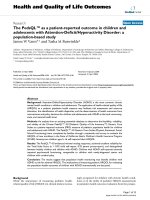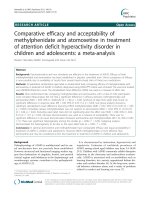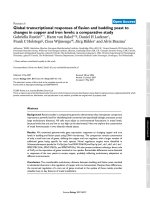BMI changes in children and adolescents attending a specialized childhood obesity center: A cohort study
Bạn đang xem bản rút gọn của tài liệu. Xem và tải ngay bản đầy đủ của tài liệu tại đây (298.62 KB, 6 trang )
Maggio et al. BMC Pediatrics 2013, 13:216
/>
RESEARCH ARTICLE
Open Access
BMI changes in children and adolescents attending
a specialized childhood obesity center: a cohort
study
Albane BR Maggio1*, Catherine Saunders Gasser1, Claudine Gal-Duding1, Maurice Beghetti2, Xavier E Martin1,
Nathalie J Farpour-Lambert1 and Catherine Chamay-Weber1
Abstract
Background: Multidisciplinary group therapies for obese children and adolescents are effective but difficult to
implement. There is a crucial need to evaluate simpler management programs that target the obese child and his
family. This study aimed to determine changes in body mass indexes (BMI) after individual family-based obesity
intervention with a pediatrician in a specialized obesity center for child and adolescent.
Methods: This cohort study included 283 patients (3.3 to 17.1 years, mean 10.7 ± 2.9) attending the Pediatric Obesity
Care Program of the Geneva University Hospitals. Medical history and development of anthropometric were
assessed in consultations. Pediatricians used an integrative approach that included cognitive behavioral techniques
(psycho-education, behavioral awareness, behavioral changes by small objectives and stimulus control) and
motivational interviewing. Forty five children were also addressed to a psychologist.
Results: Mean follow-up duration was 11.4 ± 9.8 months. The decrease in BMI z-score (mean: -0.18 ± 0.40; p < .001)
was significant for 49.5% of them. It was dependant of age, BMI at baseline (better in youngest and higher BMI) and
the total number of visits (p = .025). Additional psychological intervention was associated with reduced BMI z-score in
children aged 8 to 11 years (p = .048).
Conclusions: Individual family obesity intervention induces a significant weight reduction in half of the children and
adolescents, especially in the youngest and severely obese. This study emphasizes the need to encourage trained
pediatricians to provide individual follow up to these children and their family. Our study also confirms the beneficial
effect of a psychological intervention in selected cases.
Keywords: Childhood obesity, Adolescents, Weight management, Behavioral techniques, Development
Background
The prevalence of childhood obesity is rising rapidly, resulting in increased prevalence of associated co-morbidities.
About 20% Swiss children and adolescents are considered
overweight and 5 to 8% of them are obese [1].
The most recent Cochrane review evaluated sixty-four
randomized controlled trials in community setting of
educational, behavioral and health promotion interventions for childhood obesity [2]. Authors concluded that
comprehensive strategies involving the whole family to
* Correspondence:
1
Pediatric sport medicine and obesity care program, Division of pediatric
specialties, Department of Child and Adolescent, University Hospitals of Geneva
and University of Geneva, 6, rue Willy-Donzé, 1211, Geneva 14, Switzerland
Full list of author information is available at the end of the article
increase healthy diet and physical activity level coupled
with psycho-social support and environmental change
were more effective than those targeting the obese child
alone. Another Cochrane review stated that “combined
behavioral lifestyle interventions compared to standard
care or self-help can produce a significant and clinically
meaningful reduction in overweight in children and adolescents program” [3]. However, few studies analyzed the
effectiveness of individual family intervention with trained
pediatricians [4,5].
Therefore, the purpose of this project was to investigate
changes in body mass index (BMI) in obese children and
adolescents attending a specialized obesity care center in
individual setting.
© 2013 Maggio et al.; licensee BioMed Central Ltd. This is an open access article distributed under the terms of the Creative
Commons Attribution License ( which permits unrestricted use, distribution, and
reproduction in any medium, provided the original work is properly cited.
Maggio et al. BMC Pediatrics 2013, 13:216
/>
Methods
Study design and subjects
This was a cohort study including 283 patients (age 3.3
to 17.1 years, mean 10.7 ± 2.9) having at least two visits at
the Pediatric Obesity Care Center of the Geneva University Hospitals between January 2008 and December 2010.
Patients were followed for a minimum period of 6 months.
Children were referred by their general practitioner, school
nurses and families or by the Child and Adolescent
Department of the Geneva University Hospitals.
We excluded children or adolescents if: 1) BMI z-score
was normal, i.e. <1; 2) they attended the clinic only once;
3) they were registered in a structured multidisciplinary
family-based behavioral group therapy during this period.
Children with developmental delay or obesity related to
genetic syndrome or endocrine disease were not excluded.
Visits
All subjects visiting the center for the first time were
attributed, according to their age, to a pediatrician trained
in motivational interviewing and obesity care, assisted by a
nurse trained in behavioral techniques. Adolescents above
14 years were seen by a pediatrician certified in adolescent
medicine. The first consultation lasted an hour and
follow-up visits lasted 30 to 45 minutes each. The type
of treatment was defined at the first visit and was based on
the “CONTREPOIDS©” protocol that we developed and
described below. Some patients were referred to a psychologist when psychological problems such as depression or
anxiety disorders were suspected. The intervals between
each visit were defined according to the family needs and
the clinic’s timetable (between 1 to 3 months). There was
no intensive phase and the intervals between visits were
kept constant.
The overall number of visits and BMI z-score between
the first and last visit were calculated. If children were
no longer attending the center at the date of final data
collection (July 2011), we sent mails to their private
medical practitioner, if known, in order to collect information about their current anthropometrics data (n = 137).
We also evaluated the current follow-up status and
divided the children into three categories: 1) “current
attendees” for those who were still attending the center in
July 2011 (i.e. at least 6 months follow-up); 2) “improvement” for those who stopped the follow-up because of
improved BMI z-score (with a reduction of at least 0.2);
3) “drop-out” for those who missed several scheduled
contacts or stopped without notice.
CONTREPOIDS©’ protocol
The CONTREPOIDS©’ obesity protocol has been developed according to the current evidence on obesity
treatment [6,7]. This is an integrative approach including cognitive behavioral techniques (psycho-education,
Page 2 of 6
behavioral awareness, behaviors changes by small objectives and stimulus control) and motivational interviewing.
All pediatricians and nurses working with this protocol
have to follow a minimum of 3 days training to develop
their ability in using these techniques. These skills were
used to achieve goals in the domains of physical activity
(active transports, sports, leisure time activities), sedentary
behaviors (television viewing, electronic devices, etc.) food
and drinking habits (food choice, portion size, hunger and
satiety, beverages, etc.), as well as psychological issues and
family support [8-11]. Assessing motivation and obstacles
to behavioral change, and evaluation of modifiable lifestyle
factors affecting body weight are the key points in the
treatment. At the end of the consultation, one or two
achievable lifestyle goals were chosen with the child/
adolescent and his/her parents, depending of the age of
the child. A handbook, with different thematic cards,
was developed to help the caregivers in the treatment
management of the patient and his/her family. A family
therapist supervised the team in order to have a systemic
view of the family and its difficulties when needed.
The tre����������������������������������������������������������������������������������������������������������������������������������������������������������������������������������������������������������������������������������������������������������������������������������������������������������������������������������������������������������������������������������������������������������������������������������������������������������������������������������������������������������������������������������������������������������������������������������������������������������������������������������������������������������������������������������������������������������������������������������������������������������������������������������������������������������������������������������������������������������������������������������������������������������������������������������������������������������������������������������������������������������������������������������������������������������������������������������������������������������������������������������������������������������������������������������������������������������������������������������������������������������������������������������������������������������������������������������������������������������������������������������������������������������������������������������������������������������������������������������������������������������������������������������������������������������������������������������������������������������������������������������������������������������������������������������������������������������������������������������������������������������������������������������������������������������������������������������������������������������������������������������������������������������������������������������������������������������������������������������������������������������������������������������������������������������������������������������������������������������������������������������������������������������������������������������������������������������������������������������������������������������������������������������������������������������������������������������������������������������������������������������������������������������������������������������������������������������������������������������������������������������������������������������������������������������������������������������������������������������������������������������������������������������������������������������������������������������������������������������������������������������������������������������������������������������������������������������������������������������������������������������������������������������������������������������������������������������������������������������������������������������������������������������������������������������������������������������������������������������������������������������������������������������������������������������������������������������������������������������������������������������������������������������������������������������������������������������������������������������������������������������������������������������������������������������������������������������������������������������������������������������������������������������������������������������������������������������������������������������������������������������������������������������������������������������������������������������������������������������������������������������������������������������������������������������������������������������������������������������������������������������������������������������������������������������������������������������������������������������������������������������������������������������������������������������������������������������������������������������������������������������������������������������������������������������������������������������������������������������������������������������������������������������������������������������������������������������������������������������������������������������������������������������������������������������������������������������������������������������������������������������������������������������������������������������������������������������������������������������������������������������������������������������������������������������������������������������������������������������������������������������������������������������������������������������������������������������������������������������������������������������������������������������������������������������������������������������������������������������������������������������������������������������������������������������������������������������������������������������������������������������������������������������������������������������������������������������������������������������������������������������������������������������������������������������������������������������������������������������������������������������������������������������������������������������������������������������������������������������������������������������������������������������������������������������������������������������������������������������������������������������������������������������������������������������������������������������������������������������������������������������������������������������������������������������������������������������������������������������������������������������������������������������������������������������������������������������������������������������������������������������������������������������������������������������������������������������������������������������������������������������������������������������������������������������������������������������������������������������������������������������������������������������������������������������������������������������������������������������������������������������������������������������������������������������������������������������������������������������������������������������������������������������������������������������������������������������������������������������������������������������������������������������������������������������������������������������������������������������������������������������������������������������������������������������������������������������������������������������������������������������������������������������������������������������������������������������������������������������������������������������������������������������������������������������������������������������������������������������������������������������������������������������������������������������������������������������������������������������������������������������������������������������������������������������������������������������������������������������������������������������������������������������������������������������������������������������������������������������������������������������������������������������������������������������������������������������������������������������������������������������������������������������������������������������������������������������������������������������������������������������������������������������������������������������������������������������������������������������������������������������������������������������������������������������������������������������������������������������������������������������������������������������������������������������������������������������������������������������������������������������������������������������������������������������������������������������������������������������������������������������������������������������������������������������������������������������������������������������������������������������������������������������������������������������������������������������������������������������������������������������������������������������s food and physical activity habits, as well as the
home environment which can be more easily modified
when parents are motivated. During adolescence, family
support is also essential for weight management. However,
parents have to struggle with their child’s development of
autonomy and his growing ability to make decision and
act on his own. Interestingly, BMI changes in adolescents
were higher when both parents had normal weight, as
previously suggested by Sabin and co-workers [4]. We
may hypothesize that family support with a probably
healthiest home environment and activities and/or favorable genetic predispositions may have contributed to the
greater improvement in these adolescents.
The number of visits was also related to greater BMI
z-score changes over time. In the 8 to 11 years group,
the addition of a psychological consultation was also a
factor influencing positively the outcome. Unfortunately
too few adolescents (n = 9, 8.8%) could participate to
such consultations due to the lack of personal resources
in our center. Therefore, the sample size was probably
too low to find an association in this age group. It is well
known that overweight children and adolescents have a
high rate of psychosocial co-morbidities such as anxiety,
depressive mood disorder, adjustment disorder, or attentiondeficit/hyperactivity disorder [13-16]. Depression seems to
be especially frequent in this population, affecting almost
27% of them [17]. In fact, the risk of depression in obese
adolescents is twice more frequent than in the general
population of adolescents [17]. Screening for psychological
co-morbidities at all ages is essential in order to treat them
and to promote their adherence to recommendations and
lifestyle changes [18,19].
During the follow-up, the drop-out rate was high with
56% of the children stopping the visits after 1 year, which
is higher than the 21% reported in a comparable study [4].
However, follow-up time and BMI z-score changes were
in the average of the cohort and of other studies. Various
reasons could explain this high dropped out rate: satisfactory improvement, poor motivation or lack of results.
Some families also appeared to be overwhelmed by
psycho-social problems, with their child’s obesity being a
secondary issue. Furthermore, the importance of personal,
Table 2 Development according to age groups (n = 283)
< 8 years
8 to 11 years
> 12 years
Number, n (%)
51 (18)
131 (46)
101 (36)
Age (years)
6.3 ± 1.3
10.1 ± 1.2
13.7 ± 1.1
Gender girls, n (%)
27 (53)
74 (57)
44 (43)
Follow-up time (months)
13.2 ± 10.6§
12.5 ± 9.9¥
9.0 ± 8.8§,¥
Number of visits
5.1 ± 3.6
4.6 ± 3.0
4.3 ± 2.9
BMI z-score at inclusion
3.6 ± 1.2§
2.5 ± 0.7§
2.5 ± 0.7§
BMI z-score change
-0.40 ± 0.56§,*
-0.15 ± 0.37§,*
-0.12 ± 0.31§,*
Psychological intervention, n (%)
11 (21.6)
25 (19.1)
9 (8.8)
§
p < .001 between the 2 groups.
¥
p < .001 between the 2 groups.
* p < 0.001 for intra-group BMI z-score change.
Maggio et al. BMC Pediatrics 2013, 13:216
/>
Page 5 of 6
**
**
Figure 1 BMI z-score development per age groups. ** p < .001. Plain line represents no change in BMI z-score.
moral and sometime financial commitment in the treatment could be discouraging for these families. These data
suggests the difficulties for families to engage in the long
term and the challenge that pediatricians are facing in
their practice.
The strength of this study was the large number of
overweight or obese children and adolescents included
in this longitudinal analysis. Compared to a group therapy,
this outpatient therapy protocol was simple and could
be easily performed by trained primary care providers in
private practices or community care centers. Families
appreciated the possibility of making an individual appointment according to their needs.
The main limitation of this study was the prospective
longitudinal design instead of a randomized controlled
trial. However, we do not think that it was ethical to leave
overweight patients for a long period of time without
treatment. Indeed, the majority of interventional studies
have shown that without treatment, BMI z-scores increase
[2]. Furthermore, several longitudinal studies in this population have demonstrated the same magnitude of BMI
changes between uncontrolled and controlled studies.
The second limitation was the non-standardized physical
activity training: even if encouraged at least once a week,
it was difficult to evaluate its impact on the results. The
third limitation was the high drop-out rate that could
weaken the efficacy of this approach. Nevertheless, we can
observe that the results were good, even in the drop-out
group, with a quite long follow-up time. It is also important
to realize that not every child and family are ready to do
some changes at the moment of the consultation. Some
families were sent by their health care providers (physician,
nurse) or family members with no self-motivation, and/or
came to the consultation in order to find a quick and easy
way to lose weight as proposed in many medias.
Conclusion
This study highlights the fact that an individual and lowintensity family-based behavioral treatment during a year
in an outpatient obesity clinic decrease BMI z-score in half
of the children and adolescents, especially for the youngest
and most severe obese children. The changes were of
similar magnitude compared to intensive and complex
multidisciplinary treatments previously described in the
literature. Our findings also confirmed that a careful psychological evaluation is needed to enhance the success of
the therapy, as many of them suffer from bullying, depression or other psychological condition that can interfere
with the treatment. The greatest challenge is to promote
and keep up motivation to limit drop-outs and sustain
long-term behavioral changes. Further studies are required
to evaluate the long-term results of individual therapeutic
intervention.
Maggio et al. BMC Pediatrics 2013, 13:216
/>
Page 6 of 6
Abbreviation
BMI: Body mass index.
13.
Competing interests
The authors have no conflicts of interest to declare. This study was not
supported financially and there is no non-financial competing interest.
14.
15.
Authors’ contributions
AM: Dr. M conceptualized and designed the study, drafted and carried out
the initial manuscript, and approved the final manuscript as submitted. CSG:
Dr. S conceptualized and designed the study, reviewed and revised the
manuscript, and approved the final manuscript as submitted. CG-D: Ms. G-D
coordinated and supervised data collection, critically reviewed the manuscript,
and approved the final manuscript as submitted. MB: Dr. B reviewed and revised
the manuscript, and approved the final manuscript as submitted. XM: Mr. M
coordinated and supervised data collection, critically reviewed the manuscript,
and approved the final manuscript as submitted. NF-L: Dr. F-L reviewed and
revised the manuscript, and approved the final manuscript as submitted. CC-W:
Dr. C-W drafted and carried out the initial manuscript, and approved the final
manuscript as submitted.
Acknowledgements
We thank the subjects for volunteering for the study, and also Michelle
Mugnier (nurse) and Lydia Lanza (psychologist) for their assistance.
Author details
1
Pediatric sport medicine and obesity care program, Division of pediatric
specialties, Department of Child and Adolescent, University Hospitals of Geneva
and University of Geneva, 6, rue Willy-Donzé, 1211, Geneva 14, Switzerland.
2
Pediatric Cardiology Unit, Division of pediatric specialties, Department of Child
and Adolescent, University Hospitals of Geneva and University of Geneva,
Geneva, Switzerland.
16.
17.
18.
19.
index-for-age: Methods and development. Organization GWH; 2006:312.
/>Puder JJ, Munsch S: Psychological correlates of childhood obesity. Int J
Obes (Lond) 2010, 34(Suppl 2):S37–S43.
Griffiths LJ, Parsons TJ, Hill AJ: Self-esteem and quality of life in obese
children and adolescents: a systematic review. Int J Pediatr Obes 2010,
5(4):282–304.
Janicke DM, Harman JS, Kelleher KJ, Zhang J: Psychiatric diagnosis in
children and adolescents with obesity-related health conditions. J Dev
Behav Pediatr 2008, 29(4):276–284.
Hebebrand J, Herpertz-Dahlmann B: Psychological and psychiatric aspects
of pediatric obesity. Child Adolesc Psychiatr Clin N Am 2009, 18(1):49–65.
Sjoberg RL, Nilsson KW, Leppert J: Obesity, shame, and depression in schoolaged children: a population-based study. Pediatrics 2005, 116(3):e389–e392.
Kovacs M, Goldston D, Obrosky DS, Iyengar S: Prevalence and predictors of
pervasive noncompliance with medical treatment among youths with
insulin-dependent diabetes mellitus. J Am Acad Child Adolesc Psychiatry
1992, 31(6):1112–1119.
Storch EA, Milsom VA, Debraganza N, Lewin AB, Geffken GR, Silverstein JH:
Peer victimization, psychosocial adjustment, and physical activity in
overweight and at-risk-for-overweight youth. J Pediatr Psychol 2007,
32(1):80–89.
doi:10.1186/1471-2431-13-216
Cite this article as: Maggio et al.: BMI changes in children and adolescents
attending a specialized childhood obesity center: a cohort study. BMC
Pediatrics 2013 13:216.
Received: 18 March 2013 Accepted: 14 December 2013
Published: 26 December 2013
References
1. Zimmermann MB, Gubeli C, Puntener C, Molinari L: Overweight and
obesity in 6-12 year old children in Switzerland. Swiss Med Wkly 2004,
134(35–36):523–528.
2. Waters E, de Silva-Sanigorski A, Hall BJ, Brown T, Campbell KJ, Gao Y,
Armstrong R, Prosser L, Summerbell CD: Interventions for preventing
obesity in children. Cochrane Database Syst Rev 2011, 12:CD001871.
3. Oude Luttikhuis H, Baur L, Jansen H, Shrewsbury VA, O’Malley C, Stolk RP,
Summerbell CD: Interventions for treating obesity in children. Cochrane
Database Syst Rev 2009, 1:CD001872.
4. Sabin MA, Ford A, Hunt L, Jamal R, Crowne EC, Shield JP: Which factors are
associated with a successful outcome in a weight management
programme for obese children? J Eval Clin Pract 2007, 13(3):364–368.
5. Holm JC, Gamborg M, Bille DS, Gr Nb KH, Ward LC, Faerk J: Chronic care
treatment of obese children and adolescents. Int J Pediatr Obes 2011,
6(3–4):188–196.
6. Spear BA, Barlow SE, Ervin C, Ludwig DS, Saelens BE, Schetzina KE, Taveras EM:
Recommendations for treatment of child and adolescent overweight and
obesity. Pediatrics 2007, 120(Suppl 4):S254–S288.
7. Barlow SE: Expert committee recommendations regarding the
prevention, assessment, and treatment of child and adolescent
overweight and obesity: summary report. Pediatrics 2007,
120(Suppl 4):S164–S192.
8. Whitlock EP, Orleans CT, Pender N, Allan J: Evaluating primary care behavioral
counseling interventions: an evidence-based approach. Am J Prev Med 2002,
22(4):267–284.
9. Hettema J, Steele J, Miller WR: Motivational interviewing. Annu Rev Clin
Psychol 2005, 1:91–111.
10. Epstein LH, Roemmich JN, Raynor HA: Behavioral therapy in the treatment
of pediatric obesity. Pediatric clinics of North America 2001, 48(4):981–993.
11. Jacob JJ, Isaac R: Behavioral therapy for management of obesity. Indian J
Endocrinol Metab 2012, 16(1):28–32.
12. Group. WMGRS: WHO Child Growth Standards: Length/height-for-age,
weight-for-age, weight-for-length, weight-for-height and body mass
Submit your next manuscript to BioMed Central
and take full advantage of:
• Convenient online submission
• Thorough peer review
• No space constraints or color figure charges
• Immediate publication on acceptance
• Inclusion in PubMed, CAS, Scopus and Google Scholar
• Research which is freely available for redistribution
Submit your manuscript at
www.biomedcentral.com/submit









